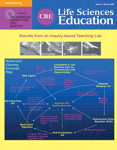Recent Research in Science Teaching and Learning
INTRODUCTION
This feature is designed to point CBE−Life Sciences Education readers to current articles of interest in life sciences education as well as more general and noteworthy publications in education research. URLs are provided for the full text of open-access articles and for the abstracts of articles not freely available. Readers who are new to education research may be interested in reading the essay that accompanied the launch of this feature, titled Grappling with the Literature of Education Research and Practice (www.lifescied.org/cgi/content/full/6/4/289).
The intention of this essay and the Current Insights feature is to provide windows through which scientists can get a clearer and more comprehensive view of education scholarship in a way that can inform their teaching. I invite readers to suggest current articles of interest in life science education as well as influential papers published in the more distant past or in the broader field of education research to be featured in Current Insights.
EDUCATION RESEARCH AND PRACTICE
1. Hamza, K. M., and Wickman, P.-O. (2008). Describing and analyzing learning in action: an empirical study of the importance of misconceptions in learning science. Sci. Educ. 92, 141–164. | |||||
Not open access. Abstract: www3.interscience.wiley.com/cgi-bin/abstract/115806896/ABSTRACT.
Although there is little debate that nonscientific ideas influence learning, when and how students' misconceptions affect their learning is less clear. For example, students may explain a scientific phenomenon in a nonscientific way in the context of an interview, but display appropriately scientific thinking in the context of a science lesson. Hamza and Wickman study the role that students' misconceptions play in learning by examining how students' misconceptions about electrochemistry, which were reported in interview studies, influence their learning as they worked with a “real” electrochemical cell.
2. Kahveci, A., Gilmer, P. J., and Southerland, S. A. (2008). Understanding chemistry professors' use of educational technologies: an activity theoretical approach. Int. J. Sci. Educ. 30, 325–351. | |||||
Not open access. Abstract: www.informaworld.com/smpp/content?content = 10.1080/09500690601188638.
Kahveci and colleagues construct and analyze two cases of undergraduate chemistry professors and their use of technology in teaching chemistry using activity theory. By considering chemistry education as an activity system, the authors are able to identify “contradictions” among the desired outcome of chemistry education (i.e., understanding) and the processes used to achieve the outcome, especially with respect to methods and priorities for using technology in the classroom.
LIFE SCIENCES EDUCATION
1. Bowling, B. V., Acra, E. E., Wang, L., Myers, M. F., Dean, G. E., Markle, G. C., Moskalik, C. L., and Huether, C. A. (2008). Development and evaluation of a genetics literacy assessment instrument for undergraduates. Genetics 178, 15–22. | |||||
Not open access. Abstract: www.genetics.org/cgi/content/abstract/178/1/15.
Bowling and colleagues describe the development and pilot of an instrument for measuring undergraduate students' genetics literacy, from definition of the content to development of the test items to evaluating validity and reliability of the measure of “genetics literacy.”
2. Marbach-Ad, G., Rotbain, Y., and Stavy, R. (2008). Using computer animation and illustration activities to improve high school students' achievement in molecular genetics. J. Res. Sci. Teach. 45, 273–292. | |||||
Not open access. Abstract: www3.interscience.wiley.com/cgi-bin/abstract/117857871/ABSTRACT.
Marbach-Ad and colleagues examine the influence of illustrations versus interactive computer animations of nucleic acid structure, DNA replication, transcription, and translation on student achievement. Although students participating in both groups increased their molecular genetics knowledge relative to a “control” (nonparticipating) group, students who worked with the computer animations were able to provide more accurate responses to open-ended questions. Also see Rotbain, Y., Marbach-Ad, G., and Stavy, R. (2007). Using a computer animation to teach high school molecular biology. J. Sci. Educ. Technol. 17, 49–58.
3. Verhoeff, R. P., Waarlo, A. J., and Boersma, K. T. (2008). Systems modeling and the development of coherent understanding of cell biology. Int. J. Sci. Educ. 30, 543–568. | |||||
Not open access. Abstract: www.informaworld.com/smpp/content∼content = a780372872?words = verhoeff%7cwaarlo&hash = 1038150576
Verhoeff and colleagues describe the use of cell biological models of increasing complexity as instructional tools, from two-dimensional depictions of free-living cells to three-dimensional models considered in the context of biological phenomena—a “systems model.” The authors investigate how different models enable students to acquire a coherent understanding of cell biology.



